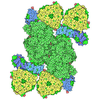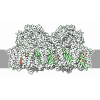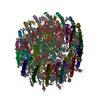[English] 日本語
 Yorodumi
Yorodumi- PDB-8wdu: Photosynthetic LH1-RC complex from the purple sulfur bacterium Al... -
+ Open data
Open data
- Basic information
Basic information
| Entry | Database: PDB / ID: 8wdu | |||||||||||||||||||||
|---|---|---|---|---|---|---|---|---|---|---|---|---|---|---|---|---|---|---|---|---|---|---|
| Title | Photosynthetic LH1-RC complex from the purple sulfur bacterium Allochromatium vinosum purified by sucrose density | |||||||||||||||||||||
 Components Components |
| |||||||||||||||||||||
 Keywords Keywords | PHOTOSYNTHESIS | |||||||||||||||||||||
| Function / homology |  Function and homology information Function and homology informationorganelle inner membrane / plasma membrane-derived chromatophore membrane / plasma membrane light-harvesting complex / bacteriochlorophyll binding / photosynthesis, light reaction / photosynthetic electron transport in photosystem II / electron transporter, transferring electrons within the cyclic electron transport pathway of photosynthesis activity / electron transfer activity / iron ion binding / heme binding ...organelle inner membrane / plasma membrane-derived chromatophore membrane / plasma membrane light-harvesting complex / bacteriochlorophyll binding / photosynthesis, light reaction / photosynthetic electron transport in photosystem II / electron transporter, transferring electrons within the cyclic electron transport pathway of photosynthesis activity / electron transfer activity / iron ion binding / heme binding / membrane / metal ion binding / plasma membrane Similarity search - Function | |||||||||||||||||||||
| Biological species |  Allochromatium vinosum DSM 180 (bacteria) Allochromatium vinosum DSM 180 (bacteria) | |||||||||||||||||||||
| Method | ELECTRON MICROSCOPY / single particle reconstruction / cryo EM / Resolution: 2.24 Å | |||||||||||||||||||||
 Authors Authors | Tani, K. / Kanno, R. / Harada, A. / Kobayashi, A. / Minamino, A. / Nakamura, N. / Ji, X.-C. / Purba, E.R. / Hall, M. / Yu, L.-J. ...Tani, K. / Kanno, R. / Harada, A. / Kobayashi, A. / Minamino, A. / Nakamura, N. / Ji, X.-C. / Purba, E.R. / Hall, M. / Yu, L.-J. / Madigan, M.T. / Mizoguchi, A. / Iwasaki, K. / Humbel, B.M. / Kimura, Y. / Wang-Otomo, Z.-Y. | |||||||||||||||||||||
| Funding support |  Japan, 6items Japan, 6items
| |||||||||||||||||||||
 Citation Citation |  Journal: Commun Biol / Year: 2024 Journal: Commun Biol / Year: 2024Title: High-resolution structure and biochemical properties of the LH1-RC photocomplex from the model purple sulfur bacterium, Allochromatium vinosum. Authors: Kazutoshi Tani / Ryo Kanno / Ayaka Harada / Yuki Kobayashi / Akane Minamino / Shinji Takenaka / Natsuki Nakamura / Xuan-Cheng Ji / Endang R Purba / Malgorzata Hall / Long-Jiang Yu / Michael ...Authors: Kazutoshi Tani / Ryo Kanno / Ayaka Harada / Yuki Kobayashi / Akane Minamino / Shinji Takenaka / Natsuki Nakamura / Xuan-Cheng Ji / Endang R Purba / Malgorzata Hall / Long-Jiang Yu / Michael T Madigan / Akira Mizoguchi / Kenji Iwasaki / Bruno M Humbel / Yukihiro Kimura / Zheng-Yu Wang-Otomo /    Abstract: The mesophilic purple sulfur phototrophic bacterium Allochromatium (Alc.) vinosum (bacterial family Chromatiaceae) has been a favored model for studies of bacterial photosynthesis and sulfur ...The mesophilic purple sulfur phototrophic bacterium Allochromatium (Alc.) vinosum (bacterial family Chromatiaceae) has been a favored model for studies of bacterial photosynthesis and sulfur metabolism, and its core light-harvesting (LH1) complex has been a focus of numerous studies of photosynthetic light reactions. However, despite intense efforts, no high-resolution structure and thorough biochemical analysis of the Alc. vinosum LH1 complex have been reported. Here we present cryo-EM structures of the Alc. vinosum LH1 complex associated with reaction center (RC) at 2.24 Å resolution. The overall structure of the Alc. vinosum LH1 resembles that of its moderately thermophilic relative Alc. tepidum in that it contains multiple pigment-binding α- and β-polypeptides. Unexpectedly, however, six Ca ions were identified in the Alc. vinosum LH1 bound to certain α1/β1- or α1/β3-polypeptides through a different Ca-binding motif from that seen in Alc. tepidum and other Chromatiaceae that contain Ca-bound LH1 complexes. Two water molecules were identified as additional Ca-coordinating ligands. Based on these results, we reexamined biochemical and spectroscopic properties of the Alc. vinosum LH1-RC. While modest but distinct effects of Ca were detected in the absorption spectrum of the Alc. vinosum LH1 complex, a marked decrease in thermostability of its LH1-RC complex was observed upon removal of Ca. The presence of Ca in the photocomplex of Alc. vinosum suggests that Ca-binding to LH1 complexes may be a common adaptation in species of Chromatiaceae for conferring spectral and thermal flexibility on this key component of their photosynthetic machinery. | |||||||||||||||||||||
| History |
|
- Structure visualization
Structure visualization
| Structure viewer | Molecule:  Molmil Molmil Jmol/JSmol Jmol/JSmol |
|---|
- Downloads & links
Downloads & links
- Download
Download
| PDBx/mmCIF format |  8wdu.cif.gz 8wdu.cif.gz | 663.3 KB | Display |  PDBx/mmCIF format PDBx/mmCIF format |
|---|---|---|---|---|
| PDB format |  pdb8wdu.ent.gz pdb8wdu.ent.gz | 559.7 KB | Display |  PDB format PDB format |
| PDBx/mmJSON format |  8wdu.json.gz 8wdu.json.gz | Tree view |  PDBx/mmJSON format PDBx/mmJSON format | |
| Others |  Other downloads Other downloads |
-Validation report
| Summary document |  8wdu_validation.pdf.gz 8wdu_validation.pdf.gz | 5.7 MB | Display |  wwPDB validaton report wwPDB validaton report |
|---|---|---|---|---|
| Full document |  8wdu_full_validation.pdf.gz 8wdu_full_validation.pdf.gz | 5.9 MB | Display | |
| Data in XML |  8wdu_validation.xml.gz 8wdu_validation.xml.gz | 148.9 KB | Display | |
| Data in CIF |  8wdu_validation.cif.gz 8wdu_validation.cif.gz | 188.5 KB | Display | |
| Arichive directory |  https://data.pdbj.org/pub/pdb/validation_reports/wd/8wdu https://data.pdbj.org/pub/pdb/validation_reports/wd/8wdu ftp://data.pdbj.org/pub/pdb/validation_reports/wd/8wdu ftp://data.pdbj.org/pub/pdb/validation_reports/wd/8wdu | HTTPS FTP |
-Related structure data
| Related structure data |  37465MC  8wdvC M: map data used to model this data C: citing same article ( |
|---|---|
| Similar structure data | Similarity search - Function & homology  F&H Search F&H Search |
- Links
Links
- Assembly
Assembly
| Deposited unit | 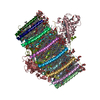
|
|---|---|
| 1 |
|
- Components
Components
-Photosynthetic reaction center ... , 2 types, 2 molecules CH
| #1: Protein | Mass: 41512.555 Da / Num. of mol.: 1 / Source method: isolated from a natural source / Source: (natural)  Allochromatium vinosum DSM 180 (bacteria) / References: UniProt: O82947 Allochromatium vinosum DSM 180 (bacteria) / References: UniProt: O82947 |
|---|---|
| #4: Protein | Mass: 28231.320 Da / Num. of mol.: 1 / Source method: isolated from a natural source / Source: (natural)  Allochromatium vinosum DSM 180 (bacteria) / References: UniProt: D3RPF6 Allochromatium vinosum DSM 180 (bacteria) / References: UniProt: D3RPF6 |
-Reaction center protein ... , 2 types, 2 molecules LM
| #2: Protein | Mass: 31217.410 Da / Num. of mol.: 1 / Source method: isolated from a natural source / Source: (natural)  Allochromatium vinosum DSM 180 (bacteria) / References: UniProt: P51762 Allochromatium vinosum DSM 180 (bacteria) / References: UniProt: P51762 |
|---|---|
| #3: Protein | Mass: 36364.242 Da / Num. of mol.: 1 / Source method: isolated from a natural source / Source: (natural)  Allochromatium vinosum DSM 180 (bacteria) / References: UniProt: P51763 Allochromatium vinosum DSM 180 (bacteria) / References: UniProt: P51763 |
-Antenna complex alpha/beta ... , 5 types, 32 molecules AIKOQ1579BJNPR24680DFSUWYEGTVXZ3
| #5: Protein/peptide | Mass: 5136.131 Da / Num. of mol.: 9 / Source method: isolated from a natural source / Source: (natural)  Allochromatium vinosum DSM 180 (bacteria) / References: UniProt: D3RP69 Allochromatium vinosum DSM 180 (bacteria) / References: UniProt: D3RP69#6: Protein/peptide | Mass: 5269.103 Da / Num. of mol.: 10 / Source method: isolated from a natural source / Source: (natural)  Allochromatium vinosum DSM 180 (bacteria) / References: UniProt: D3RP75 Allochromatium vinosum DSM 180 (bacteria) / References: UniProt: D3RP75#7: Protein | Mass: 7244.583 Da / Num. of mol.: 6 / Source method: isolated from a natural source / Source: (natural)  Allochromatium vinosum DSM 180 (bacteria) / References: UniProt: D3RP74 Allochromatium vinosum DSM 180 (bacteria) / References: UniProt: D3RP74#8: Protein/peptide | Mass: 5518.472 Da / Num. of mol.: 6 / Source method: isolated from a natural source / Source: (natural)  Allochromatium vinosum DSM 180 (bacteria) / References: UniProt: D3RP68 Allochromatium vinosum DSM 180 (bacteria) / References: UniProt: D3RP68#9: Protein | | Mass: 7392.857 Da / Num. of mol.: 1 / Source method: isolated from a natural source / Source: (natural)  Allochromatium vinosum DSM 180 (bacteria) / Strain: DSM 180 / References: UniProt: D3RP67 Allochromatium vinosum DSM 180 (bacteria) / Strain: DSM 180 / References: UniProt: D3RP67 |
|---|
-Sugars , 1 types, 22 molecules 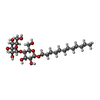
| #18: Sugar | ChemComp-LMT / |
|---|
-Non-polymers , 15 types, 425 molecules 



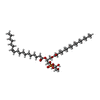
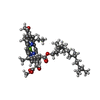
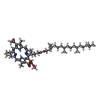

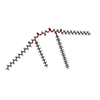




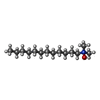















| #10: Chemical | ChemComp-HEM / #11: Chemical | ChemComp-MG / | #12: Chemical | ChemComp-Z41 / ( | #13: Chemical | ChemComp-PLM / | #14: Chemical | ChemComp-PGV / ( #15: Chemical | ChemComp-BCL / #16: Chemical | #17: Chemical | #19: Chemical | ChemComp-CDL / #20: Chemical | ChemComp-FE / | #21: Chemical | ChemComp-MQ8 / | #22: Chemical | ChemComp-CRT / #23: Chemical | ChemComp-CA / #24: Chemical | #25: Water | ChemComp-HOH / | |
|---|
-Details
| Has ligand of interest | Y |
|---|
-Experimental details
-Experiment
| Experiment | Method: ELECTRON MICROSCOPY |
|---|---|
| EM experiment | Aggregation state: PARTICLE / 3D reconstruction method: single particle reconstruction |
- Sample preparation
Sample preparation
| Component | Name: Photosynthetic LH1-RC complex from the purple sulfur phototrophic bacterium Allochromatium vinosum Type: COMPLEX / Entity ID: #1-#9 / Source: NATURAL |
|---|---|
| Molecular weight | Units: MEGADALTONS / Experimental value: NO |
| Source (natural) | Organism:  Allochromatium vinosum DSM 180 (bacteria) Allochromatium vinosum DSM 180 (bacteria) |
| Buffer solution | pH: 8 |
| Specimen | Conc.: 4 mg/ml / Embedding applied: NO / Shadowing applied: NO / Staining applied: NO / Vitrification applied: YES / Details: This sample was monodisperse. |
| Vitrification | Instrument: LEICA EM GP / Cryogen name: ETHANE / Humidity: 90 % / Chamber temperature: 277 K |
- Electron microscopy imaging
Electron microscopy imaging
| Microscopy | Model: JEOL CRYO ARM 300 |
|---|---|
| Electron gun | Electron source:  FIELD EMISSION GUN / Accelerating voltage: 300 kV / Illumination mode: FLOOD BEAM FIELD EMISSION GUN / Accelerating voltage: 300 kV / Illumination mode: FLOOD BEAM |
| Electron lens | Mode: BRIGHT FIELD / Nominal defocus max: 3200 nm / Nominal defocus min: 700 nm / Cs: 2.7 mm / Alignment procedure: COMA FREE |
| Specimen holder | Cryogen: NITROGEN / Specimen holder model: JEOL |
| Image recording | Average exposure time: 2 sec. / Electron dose: 50 e/Å2 / Detector mode: COUNTING / Film or detector model: GATAN K3 (6k x 4k) |
- Processing
Processing
| EM software |
| ||||||||||||||||||||||||||||||||||||
|---|---|---|---|---|---|---|---|---|---|---|---|---|---|---|---|---|---|---|---|---|---|---|---|---|---|---|---|---|---|---|---|---|---|---|---|---|---|
| CTF correction | Type: PHASE FLIPPING ONLY | ||||||||||||||||||||||||||||||||||||
| Particle selection | Num. of particles selected: 361654 | ||||||||||||||||||||||||||||||||||||
| 3D reconstruction | Resolution: 2.24 Å / Resolution method: FSC 0.143 CUT-OFF / Num. of particles: 252230 / Algorithm: FOURIER SPACE / Num. of class averages: 1 / Symmetry type: POINT | ||||||||||||||||||||||||||||||||||||
| Atomic model building | B value: 44 / Protocol: RIGID BODY FIT / Space: REAL / Target criteria: Correlation coefficient | ||||||||||||||||||||||||||||||||||||
| Atomic model building | PDB-ID: 7VRJ Accession code: 7VRJ / Source name: PDB / Type: experimental model | ||||||||||||||||||||||||||||||||||||
| Refine LS restraints |
|
 Movie
Movie Controller
Controller



 PDBj
PDBj
